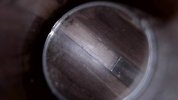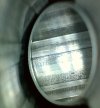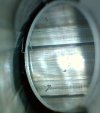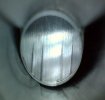Tomme boy
Well-Known Member
I have the kit coming. I want to try to smooth up a couple of throats in a few rifles.
Here is a brand new SS melonite 18" 223 wylde 1-8tw. This is only been fired by the maker. I went out a few days ago and ran almost 50 rnds through it. It removed the black coating inside but did not wear the throat in much.

I want to see if that ridge will get smoothed over. From what I am seeing on a bunch of forums this has been going on for a while now. I want to see if it will get a little more accurate with some of the varmint bullets I tried. I had a couple of smoke trails heading down range the other day. That ridge must be causing it. I did not take anymore pics but the barrel was heavily copper fouled all the way down. I got that removed.
Now what I am asking is for anyone that has shot these, how many of each grit should I do? I think I will just do it in the basement like I did with a 9mm that had an issue. i used 0.7gr bullseye for that. It would jst let the bullet pass through. 0.6gr would stick some of the bullets in the barrel. So what do you think would be about right for a 223 and a 65gr powder coated bullet to pass all the way out? I am going to try the 0.7gr first.
Then I have my 350 Legend. It has a spot about in the middle that fouls VERY BAD. Solid copper in the bore and grove. It is about 3-4" long. I think just 1 or 2 of the coarse then go straight to the fine.
I am going to have the bore scope with me so I can check after each shot. I know these can make you have a really bad day if not checking how much is being removed.
Here is a brand new SS melonite 18" 223 wylde 1-8tw. This is only been fired by the maker. I went out a few days ago and ran almost 50 rnds through it. It removed the black coating inside but did not wear the throat in much.

I want to see if that ridge will get smoothed over. From what I am seeing on a bunch of forums this has been going on for a while now. I want to see if it will get a little more accurate with some of the varmint bullets I tried. I had a couple of smoke trails heading down range the other day. That ridge must be causing it. I did not take anymore pics but the barrel was heavily copper fouled all the way down. I got that removed.
Now what I am asking is for anyone that has shot these, how many of each grit should I do? I think I will just do it in the basement like I did with a 9mm that had an issue. i used 0.7gr bullseye for that. It would jst let the bullet pass through. 0.6gr would stick some of the bullets in the barrel. So what do you think would be about right for a 223 and a 65gr powder coated bullet to pass all the way out? I am going to try the 0.7gr first.
Then I have my 350 Legend. It has a spot about in the middle that fouls VERY BAD. Solid copper in the bore and grove. It is about 3-4" long. I think just 1 or 2 of the coarse then go straight to the fine.
I am going to have the bore scope with me so I can check after each shot. I know these can make you have a really bad day if not checking how much is being removed.



